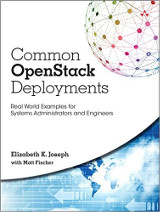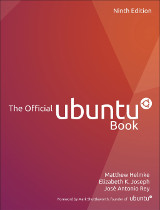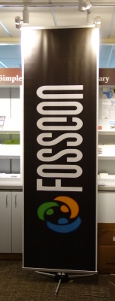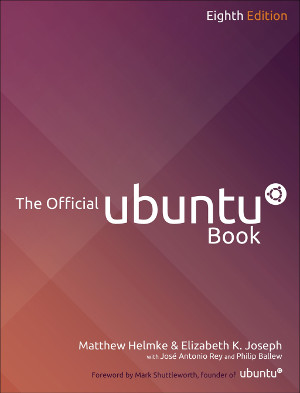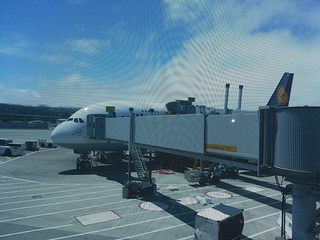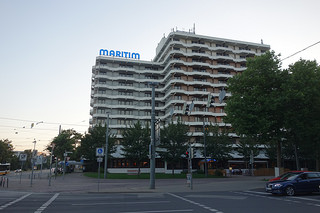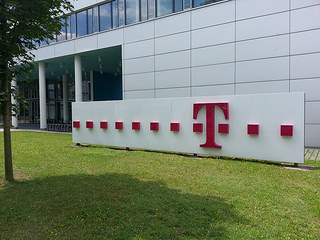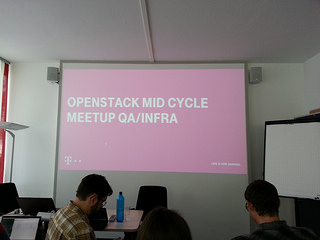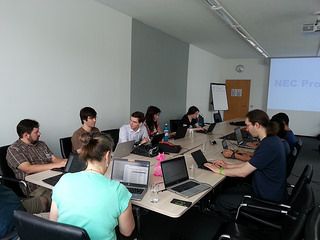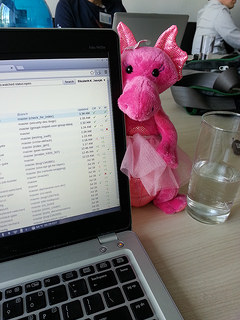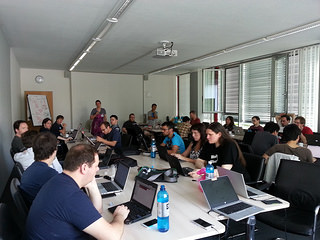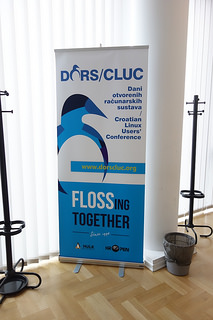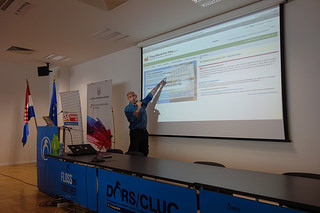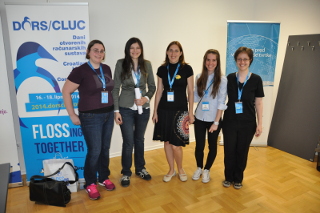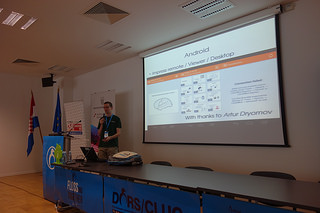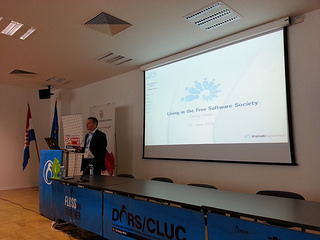Last week I had the opportunity to attend Google I/O. As someone who has only done much hardware-focused development as a hobby I’d never been to a vendor-specific developer conference. Google’s was a natural choice for me, I’m a fan of Android (yay Linux!) and their events always have cool goodies for attendees, plus it was 2 blocks from home. My friend Danita attended with me, so it was also nice to not go alone.

We registered on Tuesday, before the conference. Wednesday we headed over what we thought was early, but then after picking up breakfast and getting in line for the 9:00 keynote at 8:25 found ourselves in a line that had wrapped around the whole block of Moscone West + Intercontinental! The keynote began while we were very much still in line, and didn’t get into the main room until around 9:30. The line was still wrapped around the building when we got in, so I can’t imagine how late the other folks got in, and many of them must have ended up in some kind of overflow room since we got some of the last few seats in the main room.
Once we got in, the keynote itself was fun. Talked about Android design, Android Wear including a couple watches that we later learned we’d get to take home (woo! One we could pick up the next day, the next later this year when it’s released) and Android Auto which has partnerships with several vehicle manufacturers that will start coming out later this year (they didn’t give us one of these though). They also talked about Android TV, which was nice to hear about since it always seemed a bit strange that they had a separate division for the OS they run on tablets/phones, TVs and for Google Fiber. The keynote wrapped up by talking about Google’s cloud offerings.

By the time the keynote had finished at 11:40 the first session was pretty much over, so I grabbed some lunch and then made my way over to Who cares about new domain names? We do. If you want happy users, then you should too. In this session they announced their initiative to sell domain names as a registrar and then, most interestingly, dove into the details related to how the new naming scheme will impact web and application development when it comes to URL and email validation. Beyond just parsing of more domains, there are now considerations for UTF-8 characters included in some new domain names and how that works with DNS. I particularly liked that they showed off some of the problems Google itself was having with applications like GMail when it comes to these new domains, and how they fixed them.
The next session I went to was Making sense of online course data. I’m a big fan of MOOCs, so this was of particular interest to me. Peter Norvig and Julia Wilkowski discussed some of Google’s initiatives in developing MOOCs and what they’ve learned from their students following each one. It was refreshing to hear that they were catering to the educational needs of the students by going as far as completely breaking down old course models and doing things like offering search tools for classes if students only want to complete a portion of it, making all materials and schedule (including quiz dates and deadlines) available at the beginning and largely giving the students the ability to create their own lesson plans based on what they want to learn.
We also found time in the day to check out vendor booths and get our pictures taken with giant Androids!
The last session I attended the first day was HTTPS Everywhere. As a technical person, I’m very careful about my online activities and simply avoid authentication for non-HTTPS sites when I’m not on a trusted network. The main argument that kicked off this talk was that most people don’t do that, plus the cumulative effect of having all your HTTP-based traffic sniffed can be a major privacy violation even if there are no authentication details leaked. Fair enough. The rest of the talk covered tools and tips for migrating a site to be HTTPS-only, including how to do things properly so that your search rankings don’t plummet during the switch. Some of the key resources I gleaned from this talk include:
The first day after party was held by the conference in Yerba Buena park, and I got plenty of rest before Thursday morning when we got our chance to check out Android Auto in one of the several cars they got up to the 3rd floor for demoing! As someone who has almost always driven older cars, I am concerned about how dated the Android Auto technology will quickly become, but it does seem better than many of the current dead end technologies that seem to be shipping with cars today that are fully built in.
We also got to pick up our Android watch! After finally tracking down the developer info and charging for a bit I was able to get mine going. It’s still pretty buggy, but it is nice to get alerts on my wrist without having to pull my phone out of my purse.
Session-wise, we started out with the packed Cardboard: VR for Android session. Google Cardboard sure seems like a joke, but it’s actually a pretty cool way to use your phone for a cheap Virtual Reality environment. The session covered some of the history of the project (and of VR in general), the current apps available to try out for Cardboard and some ideas for developers.
From there I went to Transforming democracy and disasters with APIs. After seeing a presentation on Poplus when I was in Croatia, I was interested to see what Google was doing in the space of civic hacking, and was pleasantly surprised! Many of these sorts of organizations – Code for America, Poplus, Google’s initiatives, actually make efforts work together in this space. Some of the things Google has been focusing on include getting voting data to people (including who their representative is, where polling places are) accessible via the Google Civic Information API. They also talked some about the Common Alerting Protocol (CAP), which is an XML standard that Google is trying to help encourage adoption for so their and other services can more easily consume alerts worldwide for tools that use these feeds to alert populations. From this, they talked about various other sites, including:
And many more 3rd party APIs documented in this Google doc.
After lunch I went to the very crowded Nest for developers session. Even after watching this I am somewhat skeptical about how much more home automation you can get from a system that started with a thermostat and still focuses on environmental control. On the flip side, I’ve actually seen Nest “in the wild” so perhaps it gets closer to home automation than most other technologies have in this space.
Continuing my interest in sessions about civic good, I then attended Maps for good: Saving trees and saving lives with petapixel-scale computing. Presenter Rebecca Moore started off with this great story about how she stopped a very bad logging plan in her area by leveraging maps and other technology tools to give presentations around her community (see here for more). Out of her work here, and further 20% work at Google, came the birth of the initiative she currently works on full time, Google Earth Outreach.
Google Earth Outreach gives nonprofits and public benefit organizations the knowledge and resources they need to visualize their cause and tell their story in Google Earth & Maps to hundreds of millions of people.
Pretty cool stuff. She spoke more in depth about some really map geek stuff, including collection and inclusion of historical and current Landsat data in Google Earth, as well as the tools now available for organizations looking to process map data now and over time for everything from disaster relief to tracking loss of habitat.
The last slot of the day was a contentious one, so many things I wanted to see! Fortunately it’s all recorded so I can go back and see the ones I missed. I decided to go to Strengthening communities with technology: A discussion with Bay Area Impact Challenge finalists. This session featured three bay-area organizations who have been doing good in the community:
- One Degree – “The easiest way to find, manage, and share nonprofit services for you and your family.”
- Hack the Hood – “Hack the Hood provides technical training in high in-demand multimedia and tech skills to youth who will then apply their learning through real-world consulting projects with locally-owned businesses and non-profits.”
- Beyond 12 – “Ensuring all students have the opportunity to succeed in college and beyond.”
Google brought these organizations together as finalists in their Bay Area Impact Challenge, from which they all received large grants. There were some interesting observations from all these organizations, on the technical side I learned that most low income people in the bay area have a smartphone, whereas only half have a computer and internet at home. There was also higher access to text messaging abilities than to email, which was an important consideration when some organizations were launching their online services – it’s better to rely on text for registration than email. They also all work with existing organizations and are very involved with communities they serve so they make sure they are meeting the needs of their communities – which may seem obvious, but there are many technical initiatives for under-served communities that fail because they are either solving the wrong problem, have the wrong solution or aren’t very accessible.
And with that, Google I/O came to a close!
In all, it was a worthwhile experience, but as someone who is not doing application development as my core job function it was more “fun and interesting” than truly valuable (particularly with the $900 price tag). I sure do enjoy my Android watch though! And am looking forward to the round face version coming out in a few months (which we’ll also get one of!).
More photos from the event here: https://www.flickr.com/photos/pleia2/sets/72157645456636793/
